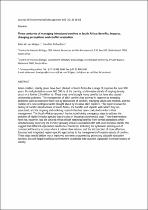 ResearchSpace
ResearchSpace
Three centuries of managing introduced conifers in South Africa: benefits, impacts, changing perceptions and conflict resolution
JavaScript is disabled for your browser. Some features of this site may not work without it.
- ResearchSpace
- →
- Research Publications/Outputs
- →
- Journal Articles
- →
- View Item
| dc.contributor.author |
Van Wilgen, BW

|
|
| dc.contributor.author |
Richardson, DM

|
|
| dc.date.accessioned | 2012-09-14T13:23:07Z | |
| dc.date.available | 2012-09-14T13:23:07Z | |
| dc.date.issued | 2012-05 | |
| dc.identifier.citation | Van Wilgen, BW and Richardson, DM. 2012. Three centuries of managing introduced conifers in South Africa: benefits, impacts, changing perceptions and conflict resolution. Journal of Environmental Management, vol. 106, pp 56-68 | en_US |
| dc.identifier.issn | 0301-4797 | |
| dc.identifier.uri | http://www.sciencedirect.com/science/article/pii/S0301479712001776 | |
| dc.identifier.uri | http://hdl.handle.net/10204/6096 | |
| dc.description | Copyright: 2012 Elsevier. This is an ABSTRACT ONLY. | en_US |
| dc.description.abstract | Alien conifers, mainly pines, have been planted in South Africa for a range of purposes for over 300 years. Formal plantations cover 660 000 ha of the country, and invasive stands of varying density occur on a further 2.9 million ha. These trees have brought many benefits but have also caused unintended problems. The management of alien conifers has evolved in response to emerging problems such as excessive water use by plantations of conifers, changing values and markets, and the realities of a new ecological order brought about by invasive alien conifers. This paper reviews the history of conifer introductions to South Africa, the benefits and impacts with which they are associated, and the ongoing and evolving research that has been conducted to inform their management. The South African approach has included taking courageous steps to address the problem of highly invasive species that are also an important commercial crop. These interventions have not, however, had the desired effect of both retaining benefits from formal plantations while simultaneously reversing the trend of growing impacts associated with self-sown invasive stands. We suggest that different approaches need to be considered, including the systematic phasing out of commercial forestry in zones where it delivers low returns, and the introduction of more effective, focussed and integrated, region-specific approaches to the management of invasive stands of conifers. These steps would deliver much improved economic outcomes by protecting valuable ecosystem services, but will require political commitment to policies that could be unpopular in certain sectors of society. | en_US |
| dc.language.iso | en | en_US |
| dc.publisher | Elsevier | en_US |
| dc.relation.ispartofseries | Workflow;9036 | |
| dc.subject | Conifers | en_US |
| dc.subject | Pine trees | en_US |
| dc.subject | Water usage | en_US |
| dc.subject | Environmental management | en_US |
| dc.subject | Biodiversity | en_US |
| dc.subject | Biological invasions | en_US |
| dc.subject | Fire | en_US |
| dc.subject | Forestry | en_US |
| dc.subject | Hydrology | en_US |
| dc.subject | Land-use | en_US |
| dc.subject | Pinus | en_US |
| dc.title | Three centuries of managing introduced conifers in South Africa: benefits, impacts, changing perceptions and conflict resolution | en_US |
| dc.type | Article | en_US |
| dc.identifier.apacitation | Van Wilgen, B., & Richardson, D. (2012). Three centuries of managing introduced conifers in South Africa: benefits, impacts, changing perceptions and conflict resolution. http://hdl.handle.net/10204/6096 | en_ZA |
| dc.identifier.chicagocitation | Van Wilgen, BW, and DM Richardson "Three centuries of managing introduced conifers in South Africa: benefits, impacts, changing perceptions and conflict resolution." (2012) http://hdl.handle.net/10204/6096 | en_ZA |
| dc.identifier.vancouvercitation | Van Wilgen B, Richardson D. Three centuries of managing introduced conifers in South Africa: benefits, impacts, changing perceptions and conflict resolution. 2012; http://hdl.handle.net/10204/6096. | en_ZA |
| dc.identifier.ris | TY - Article AU - Van Wilgen, BW AU - Richardson, DM AB - Alien conifers, mainly pines, have been planted in South Africa for a range of purposes for over 300 years. Formal plantations cover 660 000 ha of the country, and invasive stands of varying density occur on a further 2.9 million ha. These trees have brought many benefits but have also caused unintended problems. The management of alien conifers has evolved in response to emerging problems such as excessive water use by plantations of conifers, changing values and markets, and the realities of a new ecological order brought about by invasive alien conifers. This paper reviews the history of conifer introductions to South Africa, the benefits and impacts with which they are associated, and the ongoing and evolving research that has been conducted to inform their management. The South African approach has included taking courageous steps to address the problem of highly invasive species that are also an important commercial crop. These interventions have not, however, had the desired effect of both retaining benefits from formal plantations while simultaneously reversing the trend of growing impacts associated with self-sown invasive stands. We suggest that different approaches need to be considered, including the systematic phasing out of commercial forestry in zones where it delivers low returns, and the introduction of more effective, focussed and integrated, region-specific approaches to the management of invasive stands of conifers. These steps would deliver much improved economic outcomes by protecting valuable ecosystem services, but will require political commitment to policies that could be unpopular in certain sectors of society. DA - 2012-05 DB - ResearchSpace DP - CSIR KW - Conifers KW - Pine trees KW - Water usage KW - Environmental management KW - Biodiversity KW - Biological invasions KW - Fire KW - Forestry KW - Hydrology KW - Land-use KW - Pinus LK - https://researchspace.csir.co.za PY - 2012 SM - 0301-4797 T1 - Three centuries of managing introduced conifers in South Africa: benefits, impacts, changing perceptions and conflict resolution TI - Three centuries of managing introduced conifers in South Africa: benefits, impacts, changing perceptions and conflict resolution UR - http://hdl.handle.net/10204/6096 ER - | en_ZA |





